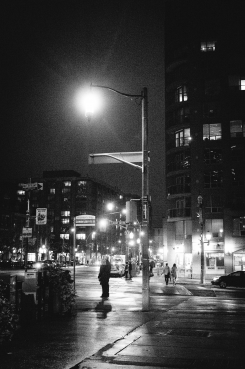Walking around late at night in Toronto, you’re probably grateful for the illumination provided by the city’s many street lights. As Toronto has evolved, it’s developed different lighting solutions based on changing needs and advances in technology. Street lights aren’t just functionally necessary, they are also an important part of a city’s aesthetics. Here are a few examples of what’s lighting our streets at night.
Victorian Gas Light
King Street
 Victorian Gas Lights, which can be found in front of St. Lawrence Hall, are all that’s left of the old gas lighting system that was first installed in 1841 by the Toronto Gas, Light, and Water Company. Before the perfection of electric lighting, gas lights were the primary lighting solution for most mid-nineteenth century cities. The use of coal gas to light these lamps meant they were often dirty, unreliable (they could easily flicker out if not constantly lit), and smelled awful. Widespread dissatisfaction led to the replacement of gaslights with electric lights in Toronto starting in 1880.
Victorian Gas Lights, which can be found in front of St. Lawrence Hall, are all that’s left of the old gas lighting system that was first installed in 1841 by the Toronto Gas, Light, and Water Company. Before the perfection of electric lighting, gas lights were the primary lighting solution for most mid-nineteenth century cities. The use of coal gas to light these lamps meant they were often dirty, unreliable (they could easily flicker out if not constantly lit), and smelled awful. Widespread dissatisfaction led to the replacement of gaslights with electric lights in Toronto starting in 1880.
Tall Arm Street Light
St. Lawrence Market
 Tall-arm street lights found around St. Lawrence Market were first installed in the 1980s as part of a plan to provide more lighting and aesthetically-pleasing colour around heritage buildings downtown. The distinctive yellow-orange light is a result of the use of high-pressure sodium, which turns that colour once the bulb is warm. A project proposed last year would replace these lights with “acorn” or “teardrop” style tall lights using metal halide, which glows white and provides more illumination for less energy.
Tall-arm street lights found around St. Lawrence Market were first installed in the 1980s as part of a plan to provide more lighting and aesthetically-pleasing colour around heritage buildings downtown. The distinctive yellow-orange light is a result of the use of high-pressure sodium, which turns that colour once the bulb is warm. A project proposed last year would replace these lights with “acorn” or “teardrop” style tall lights using metal halide, which glows white and provides more illumination for less energy.
Victorian-style Pedestrian Street Light
Front Street and Wellington Street
 A handful of these Victorian-style pedestrian streetlights stand near the famous “Flatiron” building at Front and Wellington. Designed with reference to the old gas lamps that once illuminated San Francisco, the lights mostly use high-pressure halide to produce a distinctive white glow. These metal halide lamps are a cross between fluorescent and halogen light styles. Just like the tall-arm streetlight, an aesthetic concern for nearby heritage buildings has informed the design and layout of these particular lights.
A handful of these Victorian-style pedestrian streetlights stand near the famous “Flatiron” building at Front and Wellington. Designed with reference to the old gas lamps that once illuminated San Francisco, the lights mostly use high-pressure halide to produce a distinctive white glow. These metal halide lamps are a cross between fluorescent and halogen light styles. Just like the tall-arm streetlight, an aesthetic concern for nearby heritage buildings has informed the design and layout of these particular lights.
Cobra Head Street Light
Front Street east of Yonge
 Designed by architect Donald Deskey (who also masterminded the Crest toothpaste tube) and making its debut in New York in 1958, the cobra head streetlight made its first appearance in Toronto in the 1960s. The cobra is probably the most ubiquitous streetlight in Toronto, and it was favoured throughout North America for its durability and adaptability. The cobra-head comes equipped with a ballast to regulate voltage and current, and a second light head can be added to the pole to provide cross-illumination in cases where having lights on either side of a street is impossible. Banal and a little ugly, these streetlights were nevertheless a simple solution for lighting Toronto’s streets and its then-expanding highways.
Designed by architect Donald Deskey (who also masterminded the Crest toothpaste tube) and making its debut in New York in 1958, the cobra head streetlight made its first appearance in Toronto in the 1960s. The cobra is probably the most ubiquitous streetlight in Toronto, and it was favoured throughout North America for its durability and adaptability. The cobra-head comes equipped with a ballast to regulate voltage and current, and a second light head can be added to the pole to provide cross-illumination in cases where having lights on either side of a street is impossible. Banal and a little ugly, these streetlights were nevertheless a simple solution for lighting Toronto’s streets and its then-expanding highways.

